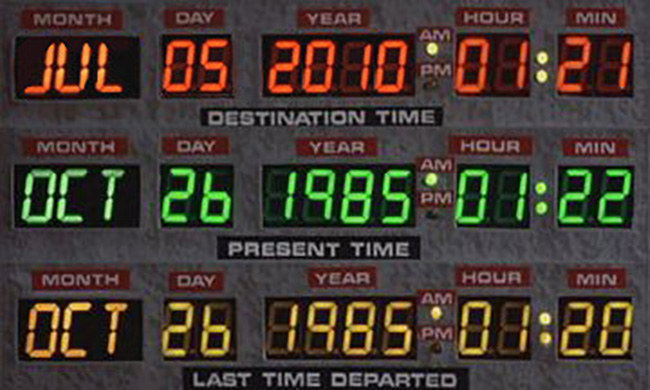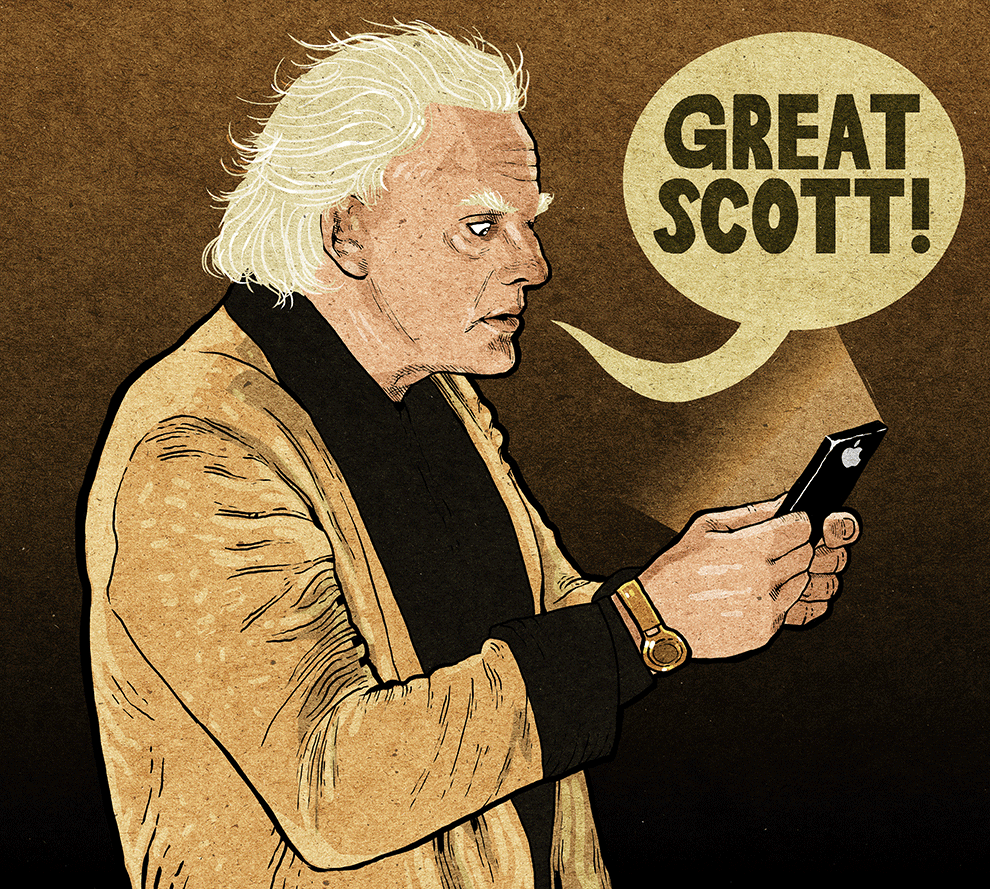5 July 2010: The day Marty McFly and Doc Brown arrived in the future in the 1989 film Back to the Future Part II, the sequel to the beloved 1985 original featuring a time-traveling teenager, his platonic mad-professor BFF, and their DeLorean time machine.
Whether you’d seen it recently or not, you knew it. We all knew it. This was a film baby boomers had seen in theatres, a film Gen Xers had grown up watching on VHS, and a film Gen Y had seen on shiny futuristic discs (or DVDs, if you prefer). It had spawned a handful of hit songs and a dozen catchphrases, and had been referenced in thousands of other films, TV shows, novels, comic books, and songs.
Ever since its release, we’d been waiting, patiently, for the future to arrive. And once it did, the internet erupted, with even the most casual of film fans rushing to tell their friends, “It’s Future Day!”
An image of the DeLorean dashboard showing the date was shared widely on Twitter, where the hashtag #futureday became the top trending topic worldwide for over 24 hours. Google searches for “Back to the Future” spiked, with nostalgia riding the crest of a time wave 25 years in the making. Stores sold out of Back to the Future DVDs and box sets. TV stations scheduled back-to-back showings of the films. Cinemas rushed to get their hands on prints. Internet commenters wondered aloud once more where their hoverboards, just like the one Marty used in the film, might be, and if they’d be arriving any time soon, please. The self-lacing Nike high-tops, too.
The outpouring was jubilant. It was also misplaced. Somehow we’d got the wrong day. The wrong future. The actual Future Day, the one Marty and Doc arrive at in Back to the Future Part II, was more than five years away, on 21 October 2015.
How did we get it so wrong? Since it was my fault, let me tell you.

Back in 2010, I was digital production editor at Total Film magazine in London, writing news and features, and looking after both the website and the Twitter account. We were a small team with modest traffic and a dedicated fanbase. With 30,000 followers, our Twitter presence was much smaller than that of rival publications. But, as it turns out, 30,000 followers is more than enough to make a fool of yourself in front of the world.
Back to the Future is a classic hero’s journey, and as Marty had Doc to set him on his path to both past and future, on the morning of 5 July, my Doc Brown arrived in the form of a project manager. She’d seen Back to the Future Part II the day before, and said she’d heard the date referenced.
“Today’s the day Marty and Doc visit in Back to the Future,” she told me. Surprised I was only hearing this now, at 10am, I interrogated a little, but nowhere near enough. I was too excited.
Being first to a juicy factoid like Future Day could result in a big tweet, and that meant new followers, new readers. Without resources, scoops at Total Film were rare, and we often had to rely on bigger publications to source news.
I could have googled. I should have googled. But being first was more important. Sometimes when a mad professor turns up with a time machine strapped to a sports car you forgo the questions and just get in.
Just after 11am on 5 July 2010, I unleashed precisely 140 characters of ignorance on the internet, among them a seemingly innocuous 10-character hashtag: #futureday.
With one boom-sounding click of a mouse, the future was history.
Great Scott! It's Future Day! In Back To The Future, Doc Brown sets the time circuits for 25yrs in the future..that day is today! #futureday
For a few seconds, time slowed. I felt woozy – time travel is disorienting, after all – and as the tweet fell into thousands of timelines, waiting to be read, I pondered some of the questions I should have asked a minute earlier:
This is too good to be true. It doesn’t sound right. Wasn’t it 30 years?
Then the notifications began appearing in my feed. Favourites and retweets and manual retweets – the Biff Tannen of tweets – were arriving at an alarming pace. People were thrilled, ecstatic even. We were a trusted source of film news, after all. They had no reason not to believe us.
Within minutes, though, a dozen or so well-informed fans had picked up on the mistake, and several were tweeting incessantly with the correct date, demanding we delete our tweet and apologise.
I’d fucked up. Publicly. I turned around to ask my boss what I should do, but he wasn’t at work. Like Marty stuck in 1885, I was on my own. Maybe if I just leave it, it will die down on its own, I thought, before quickly realising that an apology, however embarrassing, would at least help prevent any further damage.
Apologies generally begin with “I’m sorry”. My apology started with Photoshop. I took an image of the DeLorean dashboard and quickly changed the date to 5 July 2010.
“Yes, I’ll be wrong,” I laughed, “but I’ll be funny and wrong!”
Wrong again.

I posted the picture to TwitPic – this was long before Twitter allowed native images – with the caption: “We got it wrong. Apparently 5th July 2010 isn’t mentioned in Back To The Future. So we went back and changed it…”
That picture was like drinking rocket fuel and pissing on a wildfire. Nobody reads on the internet, but boy, do they love pictures.
The image tipped #futureday into the wider internet consciousness. It ended up being viewed over half a million times on TwitPic, and was quickly ripped and reshared thousands of times via email, message boards, and other social platforms — without the caption. My apology, and the truth about Future Day, was lost in time.
There were now two groups sharing the hoax: the majority who were forwarding the image to friends, and a minority trying to debunk it. It played to our two base interests on social media – the thrill of being the first to share something, and the righteous indignation of telling someone they’re wrong.
In the hours that followed, Joe Jonas, Ivanka Trump, and Elizabeth Banks, each with over a million followers, wished their fans a happy Future Day. Even Dougie Poynter, bassist of the band McFly (named for BTTF's Marty) tweeted about it:
today is the day Marty McFly travelled to the future in Back To The Future 2! SWEEEET!
Among the more unlikely people to wish his followers a happy #futureday was Frank Marshall, Hollywood veteran and the producer of all three Back to the Future movies.
The next morning, after a sleepless night watching the accidental hoax tumble through my timeline, our publicist called me. Worried that my job might be on the line, I was expecting a reprimand. Instead he was enthused.
“This is brilliant,” he told me. “Can you turn it into traffic?”
Though I was hesitant, funnelling traffic to the website was my job, and I posted a short “confession” to the website to explain what I’d done. By that point, dozens of major media outlets around the world, including The Guardian, The Telegraph, The Week, The Age, and even a fledgling BuzzFeed, had covered the hoax. I emailed as many of them as I could and asked them to link to our article, which ended up directing enough traffic to Total Film that my boss asked if I could do this every week.
In London, the Metro newspaper featured the story on page 3, which it reserves for weird news. “Twits change the future” read the headline. No argument there.

On 27 June 2012, Steve Berry, a social media manager promoting a Back to the Future Trilogy Blu-ray box set, re-photoshopped the DeLorean dashboard and posted it on Facebook. Well aware of the 2010 hoax, Berry meant for the new post to be a humorous throwback to the original. “We figured that no one would fall for the same joke twice,” he said in an interview with Mashable.
Two years is a long time on the internet, though, and most people did not get the reference. Once again, the web erupted in celebration, eventually surpassing the first hoax in terms of Google searches. And once again, the image was quickly debunked by most major outlets, including BuzzFeed, and the dejected masses were left with a three-year wait for the future.
I was at work when the second hoax broke. By that time I’d moved into a role as head of content at a social media agency, a job I got in part because of the viral success of #futureday. My then boss sent me the link, “you mad?”
Of course I was mad. I was incredulous. How dare someone rip off a stupid thing I’d done by accident two years earlier?! I quickly got over myself and calmed down, though. It was fascinating to see how quickly we forget, how much people wanted it to be true. I watched for a while in casual bemusement before getting bored and closing my Twitter tab for the rest of the day. I’d lived through Future Day once already.

In Back to the Future Part II, Doc and Marty must go back in time to fix the future. Without a DeLorean, I have been unable to do the same. I’ve had to wait for the future to arrive the old-fashioned way, and trust that time will correct itself.
Presumably, the desire to hoax BTTF fans with the wrong date will disappear after tomorrow, 21 October 2015, the actual Future Day. Though, I wouldn’t put it past someone to try the hoax again a year or two after the future has arrived.
Or, after the dozens of different dates pasted on to the DeLorean dashboard and shared over the past few years – along with the websites that fake the future for you – perhaps there have been enough fake Future Days that people won’t believe the real one.
But why were we fooled by Future Day in the first place?
A colleague at BuzzFeed who fell for the 2012 hoax, Rachael Krishna, told me she retweeted it because she wanted people to think she knew about pop culture. “I wanted to seem cool. I'd never seen the film, I just knew it was a thing.” Like many others, Rachael undid her retweet as soon as she found out it was a hoax, but even now that she’s seen the film, she says, “I still don't know the correct date.”
To the casual observer, the correct date isn’t that important. It’s the excitement of the zeitgeist, of recognising a pop culture reference, and of being part of something collective.
Yet, for some reason, other “future days” haven’t had the same effect. Judgement Day from the Terminator franchise, for example, isn't met with the same fever. This might be because the original Judgement Day was in 1997, long before social media, or because subsequent films have revised the date, making it confusing.
But perhaps the more likely answer is that no one wants to celebrate a fictional apocalypse. Back to the Future made the future cool, a place we all wanted to visit. That's the ultimate allure of Future Day: hope. It’s knowing that we’ve arrived and being able to see how far we’ve come – and how far we still have to go.
On Wednesday 21 October 2015, when I wish Twitter a happy #futureday, it will be the right day, the right future. Though it’s perhaps not the future we hoped for – our hoverboards have wheels – it’s the future we created, not the one we photoshopped.
This time, the jubilation will be real.
